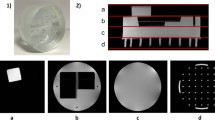Abstract
Glioblastoma multiforme (GBM) appears undifferentiated and non-enhancing on magnetic resonance (MR) imagery. As MRI does not offer adequate image quality to allow visual discrimination of the boundary between GBM focus and perifocal vasogenic edema, surgical and radiotherapy planning become difficult. The presence of noise in MR images influences the computation of radiation dosage and precludes the edge based segmentation schemes in automated software for radiation treatment planning. The performance of techniques meant for simultaneous denoising and sharpening, like high boost filters, high frequency emphasize filters and two-way anisotropic diffusion is sensitive to the selection of their operational parameters. Improper selection may cause overshoot and saturation artefacts or noisy grey level transitions can be left unsuppressed. This paper is a prospective case study of the performance of high boost filters, high frequency emphasize filters and two-way anisotropic diffusion on MR images of GBM, for their ability to suppress noise from homogeneous regions and to selectively sharpen the true morphological edges. An objective method for determining the optimum value of the operational parameters of these techniques is also demonstrated. Saturation Evaluation Index (SEI), Perceptual Sharpness Index (PSI), Edge Model based Blur Metric (EMBM), Sharpness of Ridges (SOR), Structural Similarity Index Metric (SSIM), Peak Signal to Noise Ratio (PSNR) and Noise Suppression Ratio (NSR) are the objective functions used. They account for overshoot and saturation artefacts, sharpness of the image, width of salient edges (haloes), susceptibility of edge quality to noise, feature preservation and degree of noise suppression. Two-way diffusion is found to be superior to others in all these respects. The SEI, PSI, EMBM, SOR, SSIM, PSNR and NSR exhibited by two-way diffusion are 0.0016 ± 0.0012, 0.2049 ± 0.0187, 0.0905 ± 0.0408, 2.64 × 1012 ± 1.6 × 1012, 0.9955 ± 0.0024, 38.214 ± 5.2145 and 0.3547 ± 0.0069, respectively.












Similar content being viewed by others
References
Hsieh KLC, Lo CM, Hsiao CJ (2017) Computer-aided grading of gliomas based on local and global MRI features. Comput Methods Progr Biomed 139:31–38
Kim Y, Jeon H, Othmer H (2017) The role of the tumor microenvironment in glioblastoma: a mathematical model. IEEE Trans Biomed Eng 64(3):519–527
Le M et al (2017) Personalized radiotherapy planning based on a computational tumor growth model. IEEE Trans Med Imaging 36(3):815–825
Huber T, Alber G, Bette S, Kaesmacher J, Behrens TB, Gempt J (2017) Progressive disease in glioblastoma: benefits and limitations of semi-automated volumetry. PLoS ONE, 12(2):e0173112. https://doi.org/10.1371/journal.pone.0173112
Havaei M, Davy A, Farley DW, Biard A, Courville A (2017) Brain tumor segmentation with deep neural networks. Med Image Anal 35:18–31
Li Y, Jia F, Qin J (2016) Brain tumor segmentation from multimodal magnetic resonance images via sparse representation. Artif Intell Med 73:1–13
Dupont C, Betrouni N, Reyns N, Vermandel M (2016) Image segmentation methods applied to glioblastoma: state of art and new trends. IRBM 37(3):131–143
Gupta N, Bhatele P, Khanna P (2017) Identification of Gliomas from brain MRI through adaptive segmentation and run length of centralized patterns., J Comput Sci. https://doi.org/10.1016/j.jocs.2017.02.009
Simi VR, Joseph J (2015) Segmentation of glioblastoma multiforme from MR images—a comprehensive review. Egypt J Radiol Nucl Med 46(4):1105–1110
Rajab MI, Eskandar AA (2011) Enhancement of radiographic images in patients with lung nodules. Thorac Cancer 2:109–115
Khosravy M, Gupta N, Marina N, Sethi IK, Asharif MR (2017) Perceptual adaptation of image based on Chevreul–Mach Bands Visual Phenomenon. IEEE Signal Process Lett 24(5):594–598
Unsharp masking, documentation. https://in.mathworks.com/help/images/ref/imsharpen.html
Gilboa G, Sochen N, Zeevi YY (2002) Forward-and-backward diffusion processes for adaptive image enhancement and denoising. IEEE Trans Image Process 11(7):689–703
Wang Y, Zhang L, Li P (2007) Local variance-controlled forward-and-backward diffusion for image enhancement and noise reduction. IEEE Trans Image Process 16(7):1854–1864
Joseph J, Jayaraman S, Periyasamy R, Simi VR (2017) An objective method to identify optimum clip-limit and histogram specification of contrast limited adaptive histogram equalization for MR images. Biocybern Biomed Eng 37(3):489–497
Feichtenhofer C, Fassold H, Schallauer P (2013) A perceptual image sharpness metric based on local edge gradient analysis. IEEE Signal Process Lett 20(4):379–382
Guan J, Zhang W, Gu J, Ren H (2015) No-reference blur assessment based on edge modelling. J Vis Commun Image Represent 29:1–7
Hari VS, Raj VPJ, Gopikakumari R (2013) Unsharp masking using quadratic filter for the enhancement of fingerprints in noisy background. Pattern Recognit 46(12):3198–3207
Wang Z, Bovik AC, Sheikh HR, Simoncelli EP (2004) Image quality assessment: from error visibility to structural similarity. IEEE Trans Image Process 13:600–612
Sijbers J, den Dekker AJ, Audekerke JV, Verhoye M, Dyck DV (1998) Estimation of the noise in magnitude MR images. Magn Reson Imaging 16(1)87–90
Joseph J, Periyasamy R (2018) A fully customized enhancement scheme for controlling brightness error and contrast in magnetic resonance images. Biomed Signal Process Control 39:271–283
Joseph J, Periyasamy R (2018) A polynomial model for the adaptive computation of threshold of gradient modulus in 2D anisotropic diffusion filter. Optik - Int J Light Electron Optics 157:841–853
Author information
Authors and Affiliations
Corresponding author
Ethics declarations
Conflict of interest
Authors declare that we have no conflict of interest.
Ethical Approval
No experiments on human or animals or harmful to the environment is involved in this study. No trials on human is involved. The MR images used in this study is blinded.
Research involving human participants
This article does not contain any studies with human participants performed by any of the authors.
Rights and permissions
About this article
Cite this article
Anoop, B.N., Joseph, J., Williams, J. et al. A prospective case study of high boost, high frequency emphasis and two-way diffusion filters on MR images of glioblastoma multiforme. Australas Phys Eng Sci Med 41, 415–427 (2018). https://doi.org/10.1007/s13246-018-0638-7
Received:
Accepted:
Published:
Issue Date:
DOI: https://doi.org/10.1007/s13246-018-0638-7




